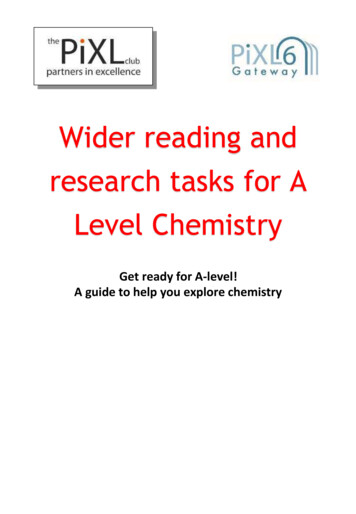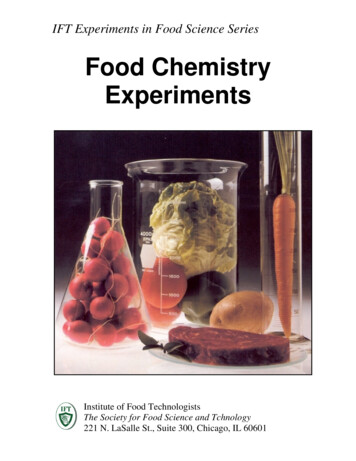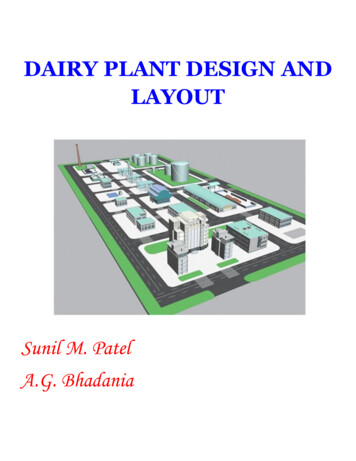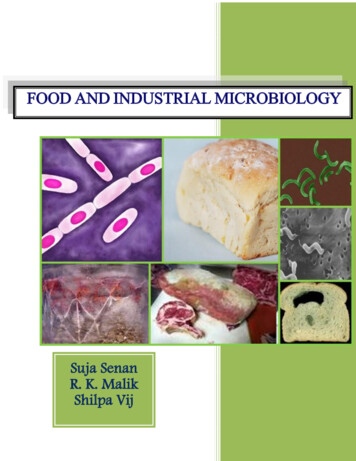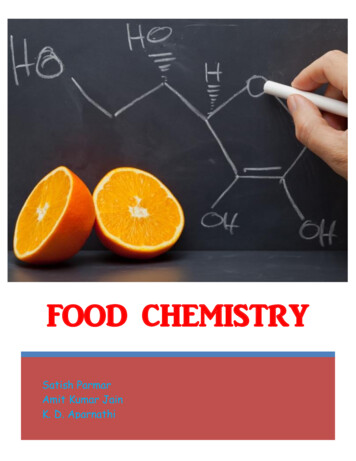
Transcription
FOOD CHEMISTRYSatish ParmarAmit Kumar JainK. D. Aparnathi
Food ChemistrySatish Parmar, Amit Kumar Jain& K. D. AparnathiDepartment of Dairy Chemistry & BiochemistryAAU, Anand
IndexL. No.Module 1Lesson 1Lesson 2Lesson 3Module 2Lesson 4Lesson 5Lesson 6Lesson 7Lesson 8Lesson 9Lesson 10Module 4Lesson 11Lesson 12Lesson 13Module 5Lesson 14Lesson 15Lesson 16Module 7Lesson 17Lesson 18Lesson 19Lesson 20Module 8Lesson 21Lesson 22Lesson 23Lesson NameWaterStructure of WaterWater binding and chemical reactions mediated by waterDetermination of moisture in foodFood ProteinsClassification and physicochemical propertiesReaction involved in processing and reactions with alkaliEnzyme catalyzed reaction involving hydrolysis adn proteolysisTheories of formation of texturized proteinsEdible fats and oils- Classification and chemical compositionReactions involved during deep frying of foodLipoprotein – definition, classification and involvement in theformation of biological membranesFood carbohydratesPolysaccharide - linear, branched and modifiedProperties and utilization of common polysaccharides – cellulose,glycogen, hemicelluolose, pectin, agar, alginate, carrageenan,gums and starchEnzymatic degradation of polysaccharides – starch Production ofdextrins and maltodextrinsMinerals in foodMain elements and trace elements in eggs, cereals & cerealproducts, vegetables and fruitsHydrolases, lipases and other important enzymes in foodUtilization in food industry and effect of inhibitors, pH andtemperatureFood AdditivesVitamins, amino acids , mineralsAroma Compounds in food and flavor enhancers – monosodiumglutamate, nucleotidesSugar substitutes – sorbitol, saccharin, cyclamateFood ColoursAntinutritional factors and food contaminantToxic trace elements, radionuclidesIndividual constituents – proteins, lipids, carbohydrates andvitamins in cereals flour and their relationship in dough makingType of flours for bread making and confectionaries and influenceof additivesPage 6-110111-116117-121122-125
Lesson 24Module 10Lesson 25Lesson 26Module 12Lesson 27Module 13Lesson 28Lesson 29ALesson 29BLesson 29CLesson 30Module 14Lesson 31Lesson 32Physical, chemical changes during baking and determination ofgluten and starch content in flourLegumesClassification, composition and physicochemical propertiesClassification, general composition, chemical changes duringripening and storageJams, Jellies and PicklesClassification, composition and preservationBeveragesClassification, composition and gradationChemical changes during processing – TeaChemical changes during processing – coffeeChemical changes during processing – CocoaDetermination of total ash, alkalinity of water soluble ash andwater extractives in tea and detection of chicory in coffee powderPreservation of foodsGeneral principles of food preservation-Physical methodsChemical preservation of 2-157158-163164-167168-173174-179180-183184
Food ChemistryModule 1 WaterLesson-1 Structure of water1.1. IntroductionWater is relatively small inorganic molecule, but organic life is highly dependent on this tiny molecule. It is theonly substance on the earth that occurs abundantly in all three physical states (gas, liquid and solid).Water is essential for life: as:(1) regulator of body temperature(2) solvent(3) carrier of nutrients and waste products(4) reactant and reaction medium(5) lubricant and plasticizer(6) stabilizer of biopolymer conformation(7) facilitator of the dynamic behavior of macromolecules (e.g. catalytic activity)Most of the fresh foods contain large amounts of water. It is one of the major component in composition of manyfoods. Each food has its own characteristic amount of this component. Effect of water on structure, appearanceand taste of foods as well as their susceptibility to spoilage depends on its amount, location, and orientation.Therefore, it is essential to know its physical properties.Water has unusually high melting point, boiling point, surface tension, permittivity, heat capacity, and heat ofphase transition values. Other unusual attribute of water include expansion upon solidification, large thermalconductivity compared to those of other liquids, moderately large thermal conductivity of ice compared to thoseof other nonmetallic solids.1.2. Water MoleculeSome the unusual properties of water are due strong intermolecular attractive forces among molecules of water.The unusual properties of water can be explained from nature of water molecules. In formation of water molecule,two hydrogen atoms form covalent bonds with oxygen. The highly electronegative oxygen of the water moleculepulls the single electron from each of the two covalently bonded hydrogen atoms towards its self, as a result eachhydrogen atom becomes partially positively charged and oxygen becomes partially negatively charged.WWW.AGRIMOON.COM5
Food ChemistryConsequently, resultant covalent bond formed between oxygen and hydrogen atoms acquires partial ioniccharacter. The bond angle of individual water molecule in vapor state is 104.5 .Figure 1.1 Structure of the water moleculeFigure 1.2 Hydrogen bonding of water molecules in a tetrahederal configurationWWW.AGRIMOON.COM6
Food Chemistry1.3. Association of Water MoleculesThe shape of water molecule and the partial polar nature of the O-H bond in the water molecule createintermolecular attraction force. Such inter molecular attraction, results in to formation of hydrogen bonds betweenthe water molecules. Therefore, water molecules associate with considerable tenacity.Figure 1.3 Hydronium ionEach water molecule involves in four hydrogen bonds with neighboring water molecules. Multiple hydrogenbonding between water molecules, forms a structure of three-dimensional network.Figure 1.4 Hydrogen bonding of water to two kinds of functional groups occurring in proteinsWWW.AGRIMOON.COM7
Food ChemistryExistence of three-dimensional hydrogen bonded structure of water is responsible for many of its unusualproperties. The extra energy needed to break intermolecular hydrogen bonds. This leads to large values for heatcapacity, melting point, boiling point, surface tension, and enthalpies of various phase transitions of water. Thedielectric constant (permittivity) of water is influenced by hydrogen bonding. Hydrogen-bonded multi-moleculardipoles increase the permittivity of water. The hydrogen bonded arrangement of water molecules is highlydynamic, allowing individual molecules to alter their hydrogen-bonding relationships with neighboringmolecules. This phenomenon facilitates mobility and fluidity of water.The open, hydrogen-bonded, tetrahedral structure of water molecules in ice is responsible for low density of waterin ice form. The extent of intermolecular hydrogen bonding among water molecules depends on temperature.Figure 1.5 Hydrogen bonding in iceWWW.AGRIMOON.COM8
Food ChemistryFigure 1.6 Unit cell of ordinary iceWith input of heat melting of ice occurs; that is, some hydrogen bonds are broken distance between nearestneighbor increases. The latter factor predominates at temperatures between 0 and 4 C, which causes net increasein density. Further warming increasing distance between nearest neighbors (thermal expansion) predominatesabove 4 C, which causes net decrease in density.***** *****WWW.AGRIMOON.COM9
Food ChemistryModule 1 WaterLesson-2 Water binding and chemical reactions mediated by water2.1. IntroductionMixing of solutes and water alters properties of each other. Hydrophilic solutes cause changes in structure andmobility of water and water causes changes in the reactivity, and structure, of hydrophilic solutes. Hydrophobicgroups of solutes interact only weakly with water. In interaction of solute with water, various bonding forcesexisting between water and solutes.To understand interaction between water and solutes at the molecular level, it is essential to knowledge aboutwater-related phenomena and related terms like water binding, hydration, and water holding capacity. The terms“water binding” and “hydration” are often used to represent tendency of water to associate with hydrophilicsubstances in foods. The extent and tenacity of water binding or hydration depends on several factors like natureof solute, salt composition, pH, and temperature.2.2. Water holding capacityTerm generally used to describe ability of a matrix of molecules to physically entrap large amounts of water insuch a way that prevents exudation of the water. The food matrices that entrap water in this manner include pectinand starch gels and tissue cells of plant and animal. This physically entrapped water does not flow from food evenwhen they are cut or minced. But this water behaves almost like pure water during food processing operations likedrying, freezing, etc. it is also available as a solvent. Thus, bulk flow of this water is restricted, but movement ofindividual molecules almost remains same as that of water molecules in a dilute solution.Impairment in this entrapment of water (i.e. holding capacity) of foods has a significant effect on quality of food.Some of the typical examples are oozing out of liquid from gel (syneresis) and exudation of liquid on thawing offrozen foods.2.3. Bound WaterBound water is not a easily identifiable entity. It is poorly understood term. Number of definitions proposed. Thebound water is that water whichis in equilibrium water of sample at appropriate temperature and relative humiditydoes not contribute significantly to permittivity and has restricted mobilityWWW.AGRIMOON.COM10
Food Chemistrydoes not freeze at low temperature (e.g. 40 C)unavailable as a solvent to dissolve additional solutesmigrate with a macromolecule during sedimentation or flowThe bound exists in vicinity of solutes molecules. Properties of this water are significantly different from that ofthe “bulk” water in the same system. In high water content foods, the bound water account for very minuteamount of the total water present. Generally, the first layer of water molecules adjacent to hydrophilic groupscomprises the bound water.2.4. Interaction between water and ionsIons and ionic groups of organic molecules hinder mobility of water molecules to a greater extent than other typesof solutes. The strength of water-ion interaction is greater than that of hydrogen bonds, between the watermolecules, however, it is much less than that of covalent bonds. Water and inorganic ions (e.g. NaCl) undergodipole-ion interactions.WWW.AGRIMOON.COM11
Food ChemistryFigure 2.1 Water as solventThe ions compete for water and alter water structure, influence the permittivity of the aqueous medium andinfluence thickness of the electric layer around colloids particle “degree of hospitality” provided to other nonaqueous solutes and to substances suspended in the medium. Thus, conformation of proteins and stability ofcolloids are profoundly influenced by nature and concentration of ions present in the system. Salting-in andsalting-out of protein are the important examples of such effect of ions.2.5. Interaction between water and hydrophilic solutes forming hydrogen bondInteractions between water and nonionic, hydrophilic solutes are weaker than that of the interactions betweenwater and ions and of the almost same strength as that of the hydrogen bonds between water molecules. Solutescapable of hydrogen bonding enhance or at least not disrupt the normal structure of pure water. However, in someinstances solutes have a disruptive influence on the normal structure of water. Urea is good example whichmarkedly disrupts normal structure of water.2.6. Interaction between water and non-polar substancesThe mixing of water and hydrophobic substances (e.g. apolar groups of fatty acids, amino acids, proteins, etc.) isthermodynamically unfavorable event (ΔG 0). Water forms a special structure in vicinity of the incompatibleapolar entities. This process has been referred to as hydrophobic hydration. Since hydrophobic hydration isthermodynamically unfavorable, water tends to minimize its association with the apolar entities. Therefore, theincompatible aqueous environment will encourage two separate apolar groups to associate, to decrease waterapolar interfacial area. This process is termed as “hydrophobic interaction”.WWW.AGRIMOON.COM12
Food Chemistry(Figure 2.2 Hydrophobic interaction)(Figure 2.3 Water orientation at hydrophobic surface)WWW.AGRIMOON.COM13
Food ChemistryA clathrate hydrate is a cage-like structure inclusion compound, in which hydrogen-bonded water layer entraps asmall apolar molecule. Formation of clathrate hydrates is an extraordinary ability of water to minimize contactwith hydrophobic groups. This structure influences conformation, reactivity, and stability of molecules likeproteins. Hydrophobic interaction is of primary importance in maintaining the tertiary structure of most proteins.It provides a major driving force for protein folding, causing many hydrophobic residues to assume positions inthe protein interior. Such association of water with hydrophobic groups of proteins has an important influence onfunctionality of the protein.(Figure 2.4 Globular protein undergoing hydrophobic interaction)The non-polar groups of other compounds such as alcohols, fatty acids, and free amino acids also can participatein hydrophobic interactions. Therefore, association of water with hydrophobic groups in proteins is veryimportant in food. Reduction in temperature causes hydrophobic interactions to become weaker and hydrogenbounds to become stronger.WWW.AGRIMOON.COM14
Food Chemistry2.7. Water ActivityA definite relationship exists between water content of food and its perishability. Concentration and dehydrationof food is carried out primarily to decrease its water content, with a view to increase concentration of solutes andthereby increase shelf life of the food. However, various foods with same amount of water content may differsignificantly in perishability, which indicates that the water content alone is not a reliable indicator forsusceptibility of food towards perishability. This is largely due to differences in intensity of association of thefood constituents with water molecules. Water having strong associations with food constituents has lower abilityto support deteriorative activities like microbial growth and chemical degradation reactions (e.g.hydrolysis), thanthat of the weakly associated water. Consequently, term water activity (aw) was developed to account for theintensity with which water associates with various nonaqueous constituents. Food stability, safety, and otherproperties can be predicted far more reliably from aw than from water content. The term “activity” was derivedfrom laws of equilibrium thermodynamics by G. N. Lewis and its application to foods was pioneered by Scott.2.7.1. DefinitionWater activity may be defined as ratio of tendency of a solvent to escape from solution (ƒ0) to tendency of thesolvent to escape from pure solvent (ƒ). At ambient pressure, ƒ/ƒ0 is almost equal to relative vapour pressure ofthe solution. Therefore, aw may also be defined as ratio of relative vapour pressure of solvent upon dissolvingnonvolatile solute to the vapour pressure of pure solvent. Therefore, relative vapor pressure is also usedinterchangeably for aw. The relative vapour is related to per cent equilibrium relative humidity (ERH) of theproduct environment.2.8. Temperature DependenceRelative vapor pressure is temperature dependent. The degree of temperature dependence is a function of moisturecontent. This behavior can be important for a packaged food because it will undergo a change in relative vapourwith a change in temperature, causing the temperature dependence of its stability to be greater than that of thesame product unpackaged.2.9. Moisture sorption isothermsA plot of water content of a food (g water/g dry material) versus aw at constant temperature is known as amoisture sorption isotherm (MSI).Information derived from MSIs are useful for concentration and dehydration processes, formulation of foodmixtures so as to avoid moisture transfer among the ingredients, determination of moisture barrier propertiesWWW.AGRIMOON.COM15
Food Chemistryneeded in a packaging material, determination of what moisture content will curtail growth of microorganisms ofinterest and prediction of the chemical and physical stability of food as a function of water content.Resorption (or adsorption) isotherms are prepared by adding water to previously dried samples. Desorptionisotherms are isotherms prepared by removing water from samples Isotherms with a sigmoidal shape arecharacteristic of most foods. Foods such as fruits, confections, and coffee extract that contain large amounts ofsugar and other small, soluble molecules and are not rich in polymeric materials exhibit a J-type isotherm.(Figure 2.5 Moisture sorption hysteresis)WWW.AGRIMOON.COM16
Food Chemistry(Figure 2.6 Generalized moisture sorption isotherm)As water is added (resorption), sample composition moves from Zone I (dry) to Zone III (high moisture).Properties of water associated with each zone differ significantly.2.9.1. Water in Zone I of the isothermThe water in Zone I of the isotherm is most strongly sorbed and least mobile, associated with accessible polarsites by water-ion or water-dipole interactions, unfreezable at -40 C, not abile to dissolve solutes, not present insufficient amount to have a plasticizing effect on the solid, behaving simply as part of the solid and constituting atiny fraction of the total water in a high-moisture food material.2.9.2. Water in Zone II of the isothermWater in Zone II of the isotherm occupies first-layer sites that are still available, associates with neighboringwater molecules and solute molecules primarily by hydrogen bonding, slightly less mobile than bulk water, mostof it is unfreezable at - 40 C, exerts a significant plasticizing action on solutes, lowers their glass transitiontemperatures and causes swelling of the solid matrix. This action, coupled with the beginning of solutionWWW.AGRIMOON.COM17
Food Chemistryprocesses, leads to acceleration in the rate of most reactions. Water in Zones I and Zone II usually constitutes lessthan 5% of the water in a high moisture food material.2.9.3. Water in Zone III of the isothermWater in Zone III of the isotherm causes glass-rubber transition in samples containing glassy regions, very largedecrease in viscosity, very large increase in molecular mobility and commensurate increases in the rates of manyreactions. This water is referred to as bulk-phase water, having properties of bulk-phase water and will not alterproperties of existing solutes, freezable, available as a solvent, readily supports the growth of microorganism andconstituting more than 95% of the total water in a high-moisture food. It is the most mobile fraction of waterexisting in any food sample governs stability.2.9.4. HysteresisAn additional complication is that an MSI prepared by addition of water (resorption) to a dry sample will notnecessarily be superimposable on an isotherm prepared by desorption. This lack of superimposability is referredto as “hysteresis”. The magnitude of hysteresis, the shape of the curves, and the inception and termination pointsof the hysteresis loop can vary considerably depending on factors such as nature of the food, physical changes itundergoes when water is removed or added temperature, rate of desorption and degree of water removal duringdesorption.2.10 Relation of food stability with its water activityFood stability and its aw are closely related in many situations. The rates of many reactions are influenced by theextent of water binding in food in which water content is less than TS ( 50%). The effect of water activity onprocesses that influence quality of food is depicted in figure. It is clear that water activity has profound influenceon the rate of many chemical reactions in food as well as on the rate of microbial growth.WWW.AGRIMOON.COM18
Food Chemistry(Figure 2.7 Water activity and a number of reaction rates)(Figure 2.8 Water activity and a number of reaction rates-stability isotherm)WWW.AGRIMOON.COM19
Food Chemistry(Figure 2.9 Water activity and a number of reaction rates-moisture sorption isotherm)Decreased water activity retards growth of microorganisms slows enzyme catalyzed reactions and also retardsnon-enzymatic browning. Enzyme activity is virtually non-existent in monolayer water (aw 0.25). Thereforegrowth of microorganisms at this level of activity is also zero. Mold and yeast start to grow when water activityreaches between 0.7-0.8, which is the upper limit of capillary water. Bacterial growth takes place when wateractivity reaches 0.8, which is the limit of loosely bound water. However yeast and mold are usually inhibitedbetween 0.8-0.88. Enzyme activity increases gradually between water activity of 0.3-0.6 and than rapidlyincreases in the loosely bound water range i.e. water activity of about 0.8.WWW.AGRIMOON.COM20
Food Chemistry(Figure 2.10 Water activity and a number of reaction rates-enzyme activity)(Figure 2.11 Water activity and a number of reaction rates-microorganism proliferation)WWW.AGRIMOON.COM21
Food ChemistryMaillard reaction strongly depends on water activity and reaches a maximum rate at a value of 0.6 to 0.7. Beyondthis range the rate of reaction decreases. The explanation for such behaviour is that in intermediate water activityrange, the reactants are all dissolved and further increase in aw leads to dilution of reactants, which adverselyaffects the reaction rate.(Figure 2.12 Water activity and a number of reaction rates-browning reaction)The effect of water activity on oxidation of lipids is complex. Lipid oxidation rates are at a high in the monolayerwater range of water activity, reach a minimum at water activity of 0.3-0.4 and then increases to a maximum at0.8. If we start at very low water activity value, it is apparent that rate of oxidation decreases as water is added.Further addition results in increased rate of reaction followed by another reduction. The interpretation for such abehaviour is that first addition interferes with oxidation probably by—1. Binding hydroperoxides and thereby interfering with their decomposition which hinders the progress ofoxidation.2. Hydration of metallic ions thereby reducing their effectiveness as catalyst of oxidation3. Quenching free radicals and by preventing access of O2 to the lipid which further provides protectionagainst oxidation.WWW.AGRIMOON.COM22
Food ChemistryThe increases observed by further addition of H2O maybe due to-1. Increased solubility of O2, thereby increasing the mobilization of O2 as well as catalysts2. The swelling of macromolecules which exposes more catalytic sitesThe second decrease observed at aw 0.8 may probably be due to dilution of the catalysts that decreases theireffectiveness.(Figure 2.13 Water activity and a number of reaction rates-lipid oxidation)Therefore, the storage stability of foods is highest when the aw lies between 0.2-0.4. Food must be preventedagainst microbial spoilage when aw is between 0.6-0.8.***** *****WWW.AGRIMOON.COM23
Food ChemistryModule 1 WaterLesson -3. Determination of moisture in food3.1. IntroductionMoisture determination is one of the most important and most widely used measurements in the processing andtesting of foods. Since the amount of dry matter in a food is inversely related to the amount of moisture itcontains. Therefore it is of direct economic importance to the processor and the consumer. Stability and quality offoods is also affected by moisture content, hence it also has a role in the safety of foods. Grains that contain toomuch water is subject to rapid deterioration from mold growth, heating, insect damage and sprouting. The rate ofbrowning of dehydrated vegetables and fruits, or oxygen absorption by egg powders increases with an increase inmoisture content. High moisture content of ghee leads to hydrolytic rancidity.Moisture determination is important in many industrial problems, i.e. in the evaluation of materials’ balance or ofprocessing losses. Moisture content (and sometimes its distribution) must be known for optimum processing offoods. Milling of cereals, mixing of dough to optimum consistency, and for producing bread with the best grain,texture and freshness retention. Moisture content must be known in determining the nutritive value of food, inexpressing results of analytical determinations on a uniform basis, and in meeting compositional standards orlaws.3.2. Some basic considerationsWater may occur in foods in at least three forms.1. A certain amount may be present as free water in the intergranular spaces and within the pores of thematerial.2. Such water retains its usual physical properties and serves as dispersing agent for the colloidal substancesand as a solvent for the crystalline compounds.3. Part of the water is absorbed on the surface of the macromolecular colloids (starches, pectins, celluloseand protein). The water is closely associated with the absorbing macromolecules by forces of absorption(vander waals or hydrogen bond).4. Finally some of the water is in a bound form in combination with various substances, i.e. water ofhydration.The rapid and accurate determination of water in foods possesses many problems. Many workers have stressedthe complexity of analytical procedures for the determination of water in foods. In practice, the guiding principleWWW.AGRIMOON.COM24
Food Chemistryhas been to prefer the method that gives the highest moisture values, with negligible decomposition volatilizationof compounds.3.3. Methods for determination of moisture in foodsMethods for determination of moisture in food can be divided into four different classes.1. Drying methods2. Distillation procedure3. Chemical assays4. Physical procedures3.3.1. Drying methodsThe procedures for determination of the moisture content specified in food standards generally involvethermal drying methods. The material is heated under carefully specified temperature and the loss of weight istaken as a measure of the moisture content of the sample. The value obtained for moisture depends on type ofoven, temperature and length of drying. Therefore, the methods provide same time approximate rather thanaccurate moisture values. The rate at which moisture can be removed from the surface of a solid phase is afunction water vapour pressure and of the drying temperature. Practical consideration dictates, however,selecting temperatures at which the decomposition of organic compounds is minimised, and yet the timerequired for quantitative drying at the selected temperature not unduly prolonged.AdvantagesDrying methods, however, are simple, relatively rapid, and permit the simultaneous analyses of large number ofsamples.Disadvantages1. Heating of a moist organic substances causes, in addition, volatilization of material and formation ofgaseous product by irreversible thermal decomposition of organic component.2. Further weight changes resulting from oxidation phenomenon (i.e. oxidation of oils) occur.3. Improperly maintained dessicator and dessicants can cause erratic results from pick up of moisture duringcooling.4. Formation of a crust that is impervious to evaporation of moisture from the centre of a dried sample.Factors affecting the precision of moisture measurements by drying methodsThe accuracy of moisture determinations is affected byWWW.AGRIMOON.COM25
Food Chemistry1. Drying temperature2. Relative humidity of the drying chamber3. Air movement in the drying chamber4. Vacuum in the chamber5. Depth and particle size of the samples6. Drying oven construction7. Number and position of samples in oven8. Diameter and type of container (material of container)The rate of evaporation is higher in aluminium than in glass or porcelain dishes, high in vacuum than in simpleovens, and high in shallow than in deep dishes. Solid materials must be pulverised under conditions that minimisecompositional changes. In drying liquids, it is essential to spread the material over a large surface. The liquid ispreferably evaporated first on a water bath, and then drying is completed in an oven.To reduce crust formation the sample is moistened with water and thoroughly mixed with sand or asbestos. Toincrease the area of drying semisolid material is spread with the help of glass rod. Sample weight is generallylimited to 3 to 5 g. Standard aluminium dishes are recommended for cereals (55 mm diameter and 15 mm height).The drying temperature used in moisture determination ranges – depending on the tested material – from 70 to155oC. The average time for drying is from below 1 hr to 6 hr or more. Certain sugars (especially fructose) aresensitive to decomposition at elevated temperatures – in honey and fruit syrups. Fructose solutions decompose attemperature above 70oC and glucose is relatively stable at 98oC. The drying of fructose, glucose or sucrosesolutions is faster and the tendency to decompose is less if the pH is below 7.Foods can be dried for moisture determination either for a selected period of time or until two successiveweighing show a negligible loss in weight (generally 1 mg for a 5 g sample, at 20 min interval).Drying time isinversely related to drying temperatures. In foods susceptible to decomposition, drying temperatures can bereduced by using vacuum ovens.3.3.2. Distillation methodsThere are two types of distillation procedures.a) In one type, water is distilled from an immiscible liquid of high boiling point. The sample suspended in amineral oil having a flash point much above the boiling point of water is heated to a predeterminedtemperature in a suitable apparatus. The water that distils off is condens
Food Chemistry WWW.AGRIMOON.COM 5 Module 1 Water Lesson-1 Structure of water 1.1. Introduction Water is relatively small inorganic molecule, but organic life is highly dependent on this tiny molecule. It is the only substance on the earth that occurs abundantly in all three physical states


